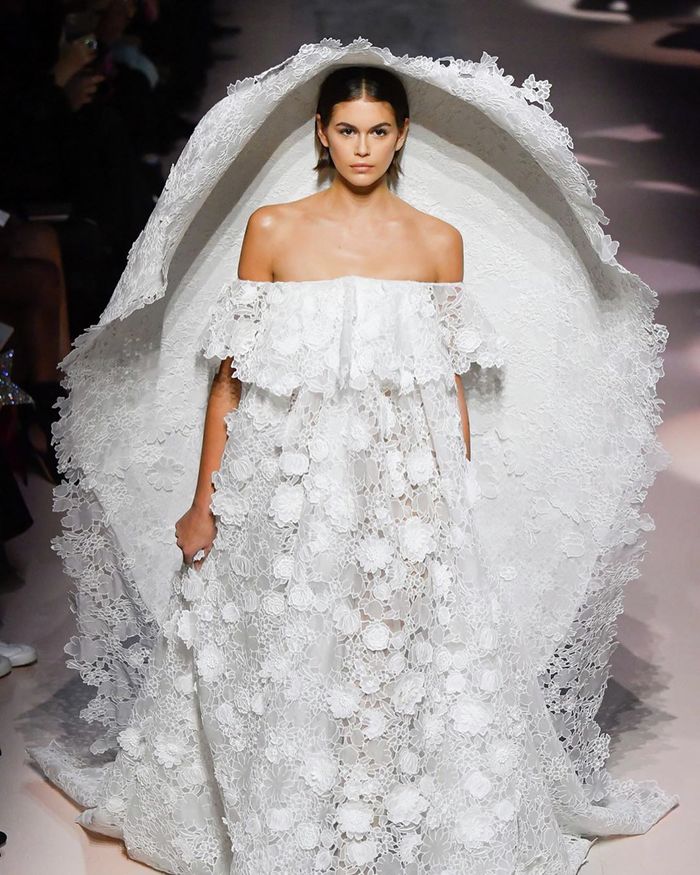Four dresses that changed the world
Sofia Johanson looks back on four dresses that have shaped fashion history
With department stores empty, a ghostly veil hanging over high-streets and the fashion industry in limbo along with the rest of the world, perhaps it is time to reflect on the designs that have changed the course of history.
Elsa Schiaparelli’s Shocking Pink Dress
Elsa Schiaparelli’s arrival on the fashion scene in the 1930s stung many, as she was coined an ‘artist who made dresses’ rather than someone worthy of the title of fashion designer. She closely associated herself with the Surrealists, collaborating with Salvador Dalí to create a white organdie gown with a lobster emblazoned across the front. Her outlandish designs met the upturned noses of many, and her bold use of colour was perceived as offensively brash; culminating in her creation of a signature shade of ‘shocking pink’ used in several of her designs. Whilst her work was not fully appreciated at the time, Schiaparelli’s wild creations had a profound impact on our view of fashion, as we learned to welcome the blurring of the line between clothes and art. Nowadays, bold and experimental gowns are increasingly admired over the mundane, with Jared Leto, Katy Perry and Billy Porter’s 2019 Met Gala looks providing examples of designers’ attempts to create the most creative, striking outfits.
Wallis Simpson’s Wedding Dress
The ‘Wally’ is often described as the dress that gave birth to our desire to emulate celebrities’ style. A mere week after Wallis Simpson’s marriage to Edward VIII, high-end boutiques had created replicas of the dress, and months later department stores were selling cheaper versions This certainly mirrors our celebrity-led trends nowadays; with fans following ‘get the look’ pages to replicate the designer outfits of their favourite star with high-street alternatives. This reverberates with our current royals, as in 2012, Kate Middleton’s Reiss dress which she wore to meet the Obamas sold out in minutes. Jumping on the trend, Banana Republic then released their own version which cost $100 less than the original in order to satisfy global demand for a cheaper alternative to replicate the Duchess’ style.
Mary Quant’s Mini Dress

Throughout the 1950s, traditional values greatly prevailed; women filled typically feminine roles, dressed in particularly conservative, ‘respectful’ attire. With the arrival of the swinging 60s, Mary Quant and her boutique on King’s Road became a go-to for women who wanted clothes designed that reflected their mood . The miniskirt became emblematic of Quant and her customers’ desire for a garment that combined practicality with a sense of energy, whilst still retaining a certain femininity. The designer said of the “Quant girl” whom she envisioned in her clothes; “she is lively - positive - opinionated”, a radically new position for young women as they were freed from the bonds of societal expectation of post-war Britain. The emancipation brought about by the new hemline extended to the professional sphere and women asserted themselves as powerful in their own right. Moreover, the minidress and the dynamism it carried with it served to overhaul London’s identity: rather than the grey, unfashionable city it had been in the 1950s, it became a symbol of free independence and began to be regarded as a fashion capital.
Elizabeth Hurley’s Safety-Pin Dress
The jaw dropping photos of Elizabeth Hurley wearing the Versace “Safety-Pin” dress to the premiere of Four Weddings and a Funeral in 1994, as escorted by Hugh Grant, are credited with launching her career. Not only this, but it made celebrities realise that an easy way of gaining publicity was simply to perform some kind of sartorial stunt on a red carpet. The numbers of stars appearing in classic, simple gowns at awards events is drastically dwindling in favour of designs that either reveal or conceal enough to shock the media. Whilst some follow Hurley’s example of promiscuity for major shock factor (Miley Cyrus’ 2013 VMAs harness and beads look certainly did so), a more recent development is the proliferation of androgynous outfits on the red carpet. Billy Porter’s 2019 Oscars tux-stroke-gown was more than striking and Billie Eilish’s consistent donning of oversized blazers and trousers has her hitting Vogue’s list of ‘Red Carpet Rulebreakers’. Whether to gain publicity, assert their sexuality, or make a socially-conscious statement, red carpet stunts are more frequent than ever and it’s hard to ignore Hurley’s safety-pin dress as a contender for the gown where it all started.
Fashion really can act as a revolutionary force, and these designs prove the power of a dress to both shape popular culture, and accord the wearer greater social liberation.
 Features / Cloudbusting: happy 10th birthday to the building you’ve never heard of30 March 2025
Features / Cloudbusting: happy 10th birthday to the building you’ve never heard of30 March 2025 News / Uni offers AI course for Lloyds employees30 March 2025
News / Uni offers AI course for Lloyds employees30 March 2025 News / Cambridge University Press criticises Meta’s ‘dismaying’ use of copyrighted material28 March 2025
News / Cambridge University Press criticises Meta’s ‘dismaying’ use of copyrighted material28 March 2025 News / Ski mask-wearing teens break into Caius accommodation27 March 2025
News / Ski mask-wearing teens break into Caius accommodation27 March 2025 Sport / Light Blues prevail in thrilling Varsity encounter29 March 2025
Sport / Light Blues prevail in thrilling Varsity encounter29 March 2025






